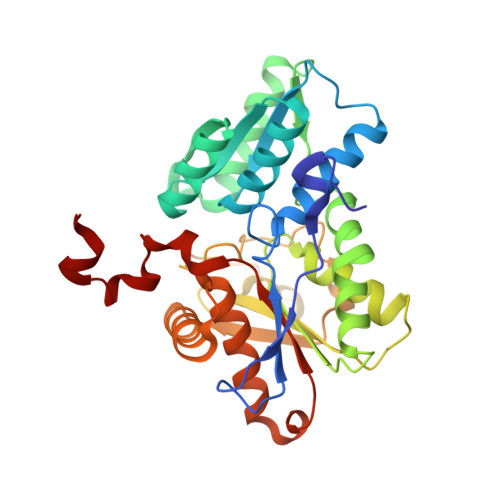Ligand binding induces a large conformational change in O-acetylserine sulfhydrylase from Salmonella typhimurium.
Burkhard, P., Tai, C.H., Ristroph, C.M., Cook, P.F., Jansonius, J.N.(1999) J Mol Biology 291: 941-953
- PubMed: 10452898
- DOI: https://doi.org/10.1006/jmbi.1999.3002
- Primary Citation of Related Structures:
1D6S - PubMed Abstract:
Covalent binding of L-methionine as an external aldimine to the pyridoxal 5'-phosphate-cofactor in the K41A mutant of O-acetylserine sulfhydrylase from Salmonella typhimurium induces a large conformational change in the protein. Methionine mimics the action of the substrate O-acetyl-L-serine during catalysis. The alpha-carboxylate moiety of L-methionine in external aldimine linkage with the active site pyridoxal 5'-phosphate forms a hydrogen bonding network to the "asparagine-loop" P67-T68-N69-G70 which adopts a different conformation than in the native protein. The side-chain nitrogen of Asn69 moves more than 7 A to make a hydrogen bond to the alpha-carboxylate group of the inhibitor. As the external aldimine is formed, the PLP tilts by 13 degrees along its longitudinal axis such that C4' moves toward the entrance to the active site and the side-chain of the methionine is directed toward the active site entrance. The local rearrangement acts as a trigger to induce a large global conformational change in the protein. A subdomain comprised of beta-strand 4, alpha-helix 3, beta-strand 5 and alpha-helix 4 moves towards the active site by a rotation of 7 degrees. This subdomain movement results in a reduction of the severe twist of its central beta-sheet and reduces the active site entrance to a small hole, giving access only to small molecules like sulfide, the second substrate, or acetate, the first product.
- Biozentrum, University of Basel, Klingelbergstrasse 70, Basel, CH-4056, Switzerland.
Organizational Affiliation:


















